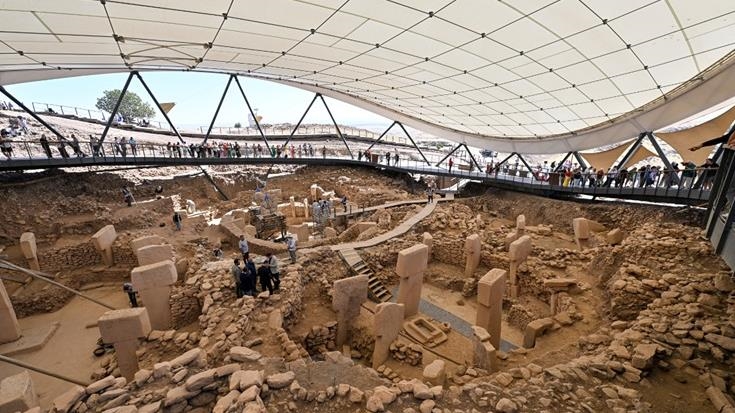Rare human statue discovered at eastern Türkiye’s Gobeklitepe sheds light on Neolithic rituals
Excavations at Türkiye’s ‘zero point of history’ yield new finds while restoration and protection efforts increase, says culture and tourism minister

SANLIURFA, Türkiye
Türkiye’s Minister of Culture and Tourism Mehmet Nuri Ersoy on Friday announced the discovery of a rare human statue at Gobeklitepe, the ancient sanctuary in southeastern Türkiye, shedding new light on Neolithic rituals and spirituality.
“We had previously encountered similar examples at Karahantepe, but this new discovery from Gobeklitepe is a highly valuable find that will shed light on the rituals and belief systems of the Neolithic Age,” Ersoy said.
He pointed out that the statue, which was mounted horizontally on a wall between structures B and D, is believed to have been specifically placed as a votive offering.
During his visit to Gobeklitepe with Japan’s Princess Akiko of Mikasa, Ersoy emphasized its significance as the world’s oldest temple, a UNESCO World Heritage site dating back 12,000 years and what he referred to as the “zero point of history.”
Conservation efforts advance
Ersoy emphasized that the excavations initiated at Gobeklitepe represent a turning point for archaeology.
“Thanks to the Future Heritage Project, we are not only conducting excavations but also restoring and preserving the structures uncovered, entrusting them to future generations,” he said.
Ersoy noted that restoration work at Gobeklitepe’s largest structure, Building C, included successfully reinforcing walls and repositioning massive standing stones weighing tons using original materials, including a special mortar utilizing goat hair.
He added that a new visitor center, parking lot, and walkways, set to open by the end of 2025, will help sustainably manage visitor interest.
“In addition, the approximately one thousand olive trees we have planted this year contribute to the protection of the site, while the geomagnetic surveys to be conducted next month will determine our future excavation strategy,” he said.
Emphasizing that Gobeklitepe is a shared heritage of all humanity, Ersoy highlighted that as part of the Tas Tepeler Project, also known as Stone Hills, 36 international academic institutions and a team of 220 experts and students are conducting archaeological excavations at 10 sites.
A legacy to protect and share with the future
Ersoy also announced that a new exhibition entitled Myths in Stone: Gobeklitepe and the World of the Last Hunters will be held from Feb. 5 to July 31 next year at Berlin’s Museum of the Ancient Near East James-Simon Gallery, showcasing 96 artifacts from the Sanliurfa Museum’s collection.
He also recalled last year’s exhibition at Rome’s 2,000-year-old Colosseum, which attracted over 6 million visitors and served as a historic meeting of the 12,000-year-old Gobeklitepe with the iconic ancient Roman site.
He emphasized that Gobeklitepe is not only an archaeological site illuminating the past but also a legacy to protect and share with future generations and all of humanity.
Ersoy also stressed that friendly relations extend beyond culture and economy, highlighting Japan’s support for archaeological work in Türkiye as a new dimension of cooperation.
Thanking Princess Akiko for her interest, he said: “I believe our friendship will grow stronger based on culture and history. Gobeklitepe is humanity’s shared heritage. Preserving and carrying this heritage into the future is our collective responsibility.”



